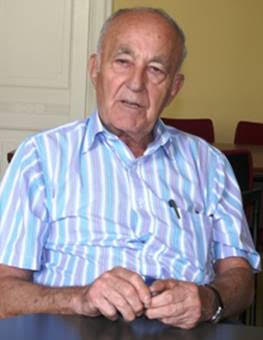
THE VOICE OF INTERNATIONAL LITHUANIA
|
VilNews has its own Google archive! Type a word in the above search box to find any article.
You can also follow us on Facebook. We have two different pages. Click to open and join.
|
Author Archive
- Posted by - (21) Comment
Need some peace of mind?
Try a boat trip on the
Nemunas and a spa visit
to beautiful Birštonas!

An old house on the Nemunas river bank near Birštonas
Text and photos: Aage Myhre
aage.myhre@VilNews.com
Lithuania’s largest river, the Nemunas, is a slow and peaceful river; with an average speed of only 1 to 2 m/s. Its total length of 937 km makes it the 14th largest river in Europe. 459 km flow in Belarus, 359 km in Lithuania. Well, we called it peaceful, but if you agree to join us for a trip to the small resort town of Birštonas, one hour’s drive from Vilnius, you will soon realise that it’s right here that Nemunas gets a bit crazy, making four large loops without any other reason than this that Birštonas needed some special attention and minerals that over the centuries has made it such an attractive spa resort. Birštonas is suitable for therapy and recreation all year round with its curative peat and mineral water used in treating chronic diseases of peripheral nervous system, gastrointestinal, respiratory and blood circulation systems. The first patients were treated in Birštonas as early as 1840. Enjoy!
Rūta Kapočinskaitė is my Birštonas heroine. She has understood what it takes to represent a tourist destination with energy and genuine attention to the visitor - much more so than representatives of the majority of destinations in this country. So, if you are a Lithuanian working in the tourist trade, don’t miss the chance to learn from Rūta. It takes enthusiasm to promote a destination, and Rūta has got plenty of exactly that. She is simply good!


Why should people come to Birštonas? This is my first question to Rūta, and her reply is quick and without hesitation; “Because of everything we have to offer. There is simply no better place than Birštonas!”
But let me tell you a bit more about the history of this remarkable place before Ruta start her sightseeing show with us.
As I said above, it is the loops of Nemunas River that has created the very special landscape here. In earlier times, the loops represented great difficulty for ship navigators. Even the rather precise maps of the Grand Duchy (Magni Ducatus Lithuaniae) had not registered the loops correctly, and it was only in 1777 that such registration works were started. In 1852, the Vilnius University professor Abicht finally succeeded in outlining the loops in a proper and correct manner.

The river loops have made the Birštonas landscapes more rolling than the rest of Lithuania. Here you can find rather deep valleys and steep riverside banks of more than 40 metres height. The river itself is on its widest four kilometres.
The other landscape feature I am sure you will recognise as soon as you show up in Birštonas is the fantastic forests which occupy more than half of the municipal area. Beautiful, tall pine trees are the dominant, but also birch-trees and other broad-leaved trees will certainly make your forest walk more than unusual.


It goes without saying that there is an extensive wild life along the Nemunas shores. Birds, animals and fish in different variants and sizes – they’re all here. The biggest fish caught here is said to have been a catfish of close to 60 kgs!

The biggest fish caught here in Nemunas next to Birštonas is said to have been a catfish of close to 60 kgs!
People have been living peacefully in the Birštonas area since ancient times, with its first recordings back to the 4th millennium BC. In the 13th century, however, the crusaders changed this peaceful life, and the people of the present Birštonas lands had to start defending themselves from conquer campaigns. This lead to the construction of mounds, wooden fortresses and defensive castles. The most famous wooden fortress was erected on a mound called Vytautas Hill, and it was next to this fortress that the town of Birstonas started growing up in the 14th century. The name Birštonas was first mentioned in the 1382 chronicles of the Crusaders, as “a homestead next to salty water” (Birstain, Birstan).
After the 1410 Grunwald Battle, the fortresses lost their significance, and the victorious Grand Duke himself (Vytautas the Great) took over the Birstonas Castle as his private hunting mansion. Since that moment, Birštonas became a very much beloved area for hunting, visited by many European Kings and Dukes on the invitation from Grand Duke Vytautas. The forest keeps the name Žvėrinčius (full of wild animals) after these glorious times for both Birštonas and Lithuania.
In 1519 Birštonas was already referenced as a town. It had about 600 inhabitants, and there were four beer-houses and two whisky taverns. A town of hospitality already back then!
I have not been able to find out if the whisky was brought to Birštonas by Scotsmen, but what I have found is that the Hungarians started showing interest for the area already in the 16th century, even being rendered the rights of the city for 40 years. In these times royal stud of horses thrived in Birštonas.
Modern Birštonas, however, has first of all gained its fame after the 19th century detection of healing mineral water from several springs in the area. 1846 is the great year for Birštonas as a spa resort, from then of visitors from many countries have come here for their healing.
“So you see, Birštonas is really the place to visit if you want to heal your body or soothe your soul.” Rūta is back, waking me up from my travel back in time. And from now on, I am again under her attentive control, going for a sightseeing walk around Birštonas – because here the distances are short and no car or bus is needed.

Go for a sanatorium week-end in the “Royal Spa Resort” of Birštonas


“A week-end in Birštonas helps for almost everything”, explains our enthusiastic guide Rūta Kapočinskaitė when she leads us to the place where the town’s first sanatorium was built in 1846, where today’s modern sanatorium “Tulpe” now is located, at the very bank of the Nemunas River. And it’s here you should come to spend a week-end to heal your body and soul.
Birštonas is recently accepted as a member of the very fashionable club “The Royal Spas of Europe” which all have as its common intention to meet the highest quality described in a catalogue of criteria which includes what has to be complied with by the Royal Spas of Europe with respect to their offers for health, wellness and fitness, thermal facilities, medical care, infrastructure, standards of hotels and cultural events.
But we are in Birštonas now, and if you agree to come here for a weekend, the treatments will start already upon your arrival on Friday afternoon, and continue throughout the weekend with all kinds of baths and treatments – in mineral or herbal water, or in healing mud. Massage procedures of all kinds are also important ingredients in the programme.
I have, myself, no clue what they mean, all these terms the experts in the Tulpe Sanatorium use when they try to explain me about their methods and the results thereof, so I have no other choice than to “cheat” a little bit by simply referring to what is written in their brochure:
“A few days in Birštonas are sufficient to regain spiritual equilibrium, serenity, good mood, to get rid of nervousness, general body weariness, and tiredness. The microclimate of Birstonas resort and mineral waters are most suitable for treating illnesses of digestive system, joints, spines, and gynaecological and oenological diseases. The place has a positive effect on the central nervous system, suits the purpose of the genera rehabilitation and, of course, is ideal for having a rest, The personified health programme that is prepared by qualified specialists according to the client’s needs with a menu prepared by dietologists (whatever that is) will ensure you recuperate quickly and regain energy with the best of spirits”.
The Tulpe Sanatorium can also offer a place for you to stay during your visit, in their own little hotel close to the river and with the town and its surrounding forests within a few minutes walk away.
And in addition to this, the Sanatorium offers you to talk with your colleagues in one of their conference rooms, where up to 100 persons can be seated.
“You see,” says Rūta now, “Birštonas has it all.”
Experience a healthy outdoor life in Birštonas

I knew in advance that Birštonas had very much to offer in the summertime, when people here are becoming very active with river-sports in their boats, canoes and kayaks, or on bikes, horseback or foot in the forests and the sport arenas. But I did not know that Birštonas now also has quite a bit to offer during the winter time, especially after the two new ski slopes opened, almost in the very centre of the city.
Rūta grabbed the director of the ski-centre, ……., out of his office asking him to come up and show us the two tracks – the 160 m long blue track and the 300 m long red track – so here we are, seeing that Birstonas has developed their own Alp mood with modern ski lifts, snow canons and other equipment that makes this place a real paradise for skiing enthusiasts.
And, as if that should not be enough, next to the ski tracks a skating ring for kids has been developed.
But, of course, the summer time is soon here, and that’s when Birštonas really shows you what a healthy outdoor life means.


Birštono Seklytėlė - a genuine country tavern on top of a steep river bank

We are in Birštonas and lunchtime is approaching. So, like so many others have been doing before us both during and after the Soviet times, we drive up the hill to the famous tavern (seklytėlė) on top of the Nemunas River bank two kilometres from the town centre.
This is the place where you certainly will get a feeling of being close to the nature either you sit inside or on the view-terrace outside. The restaurant windows and the terrace both overlook the spectacular landscape and the river itself. This is the place for a rich lunch or a nice dinner, relaxed and in the middle of the nature. Overlooking the Nemunas River this genuine tavern is a favourite of locals and foreign visitors alike. It offers a vast array of tasty food and beverages in a cosy setting with original Lithuanian interiors and a fire place that is lit on cold evenings. On most evenings make live music makses this a highly desirable place to while away the hours with friends.

We had a good lunch consisting of local fish from the river and beef from the fields nearby, and our waiter really did his utmost to make us feel at home.
So our conclusion is simple but tasteful; - that the Birštono Seklytėlė is a must to visit for everyone coming to this region.



- Bookmark :
- Digg
- del.icio.us
- Stumbleupon
- Redit it
- Posted by - (3) Comment
Message to all U.S.-Lithuanians:
Come home, your
country needs you!
By Aage Myhre
Editor-in-Chief
aage.myhre@VilNews.com
Our series on US-Lithuanians and their contact with the home country Lithuania has come to an end. Through nearly two months we have brought stories and articles in which the goal has been to shed light on both issues and individual cases, and it shall not be denied that many of the articles have revealed major differences, different mindsets and sometimes bitterness between today's Lithuanians and various emigrant groups in United States. There is still no doubt in my mind that there is much genuine love for the homeland in many diaspora groups, even among the descendants of people who came to America more than 100 years ago when the first major exodus from Lithuania took place.
My thinking is that today’s Lithuanian leaders should do whatever they could to invite and facilitate for as many emigrants as possible to return home, preferably for permanent living but at least for more frequent visits. There should be spared no effort to create more attractive conditions for the return of the fellow-countrymen to Lithuania. The US-Lithuanians’ wisdom, experience, knowledge and investments is still very much needed here.
Thousands of exiles spent half a century in America since WWII, waiting to come home, dreaming of a Lithuania as it was in its pre-communist days. But relatively few did move home despite the newfound freedom for their home country in 1990-1991. The contrast between living in the United States and in a country where the understanding of democracy and
Western-style leadership that still today is quite deficient has probably appeared too dramatic for many. Had liberation
come in the 1960s this would probably have been completely different.
|
|
There have, however, also been good moves to reunite the Lithuanian people in the USA and Lithuania. In 1998 Lithuanians elected a Lithuanian-American President, Valdas Adamkus, who returned to his homeland in 1997 after nearly 50 years in the U.S. Adamkus' post and position was largely symbolic, and he vowed to curb corruption, steer the country westward and restore "moral dignity" to government. As the nation's neighbours, Latvia and Estonia, Lithuania hit the fast track to NATO and E.U. membership, he was calculating that left-behind Lithuania would be ready for forward movement as well-to bury the ghosts from its Nazi and communist occupation, settle old scores and move westward into the 21st century. But the resistance against him was huge. In 1998, a member of the far-left wing put it: "Adamkus won the presidential elections by 14,000 votes. Is that a mandate to import Americans?" |
Despite controversy, Adamkus continued to believe that importing Lithuanian-Americans was good for his country. "You know that when you need experience you can get it," he said. And even some of Adamkus' political rivals agreed. Vytautas Landsbergis, the fiery parliament speaker who led the Sajudis movement that won Lithuania's independence, welcomed the Americans. He said they had brought "a feeling of hope that helped Lithuania overcome the danger of depression.
Suspicion, however, does hang in the air, still today. One of Adamkus' goals was to deal with some of the dark corners of Lithuanian history, bringing to justice those who too eagerly aided foreign occupiers-first the Nazis, then the Soviets. In the late 1990s the Seimas passed a "lustration" law banning former officers of the Soviet KGB from holding jobs in the judiciary, security forces, diplomatic corps, banks and even in some private sector industries. To many Lithuanians Adamkus, was the man to heal his homeland's wounds, but the challenge was huge and the old ‘nomenklatura’ continued to play main roles in a society that desperately needed a total clean up.
|
|
Another interesting move took place when retired U.S. Army Colonel Jonas Kronkaitis became commander of the Lithuanian armed forces. Kronkaitis, who fled Lithuania as a young boy during World War II, served 27 years in the U.S. Army, including two years in Vietnam, and went through Ranger training with Colin Powell. But despite those military qualifications, Kronkaitis, whose reform agenda was focused on getting the tiny army up to NATO level in shortest possible time, did not sit well with some Lithuanians, especially the Soviet-trained members of the elite officer corps and the hard-liners among the reformed communists in the parliament. People like Adamkus and Kronkaitis have done much to establish and improve ties between Lithuanians in the U.S. and in the home country here on the Baltic Sea shore. Also, many others could be mentioned. But there is still very much work to do regarding reconciliation and bridge building. |
We have through this series sought to identify younger US-Lithuanians and other people who have ties and feelings towards their homeland even though they have never lived here. I think we have succeeded relatively well with regard to these efforts, and I hope that our goals of building new bridges with the help of communication has sown some small seeds that may lead to renewed contacts and more mutual understanding.
I hope to see many of our U.S. readers move here to
actively take part in the further development of the tiny but amazing country
called Lithuania! Thank you for following us!
- Bookmark :
- Digg
- del.icio.us
- Stumbleupon
- Redit it
U.S.-Nordic-Baltic cooperation
- Posted by - (0) Comment
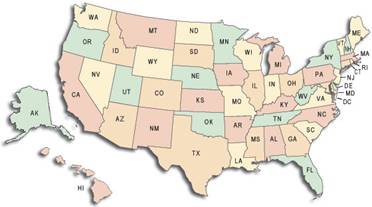
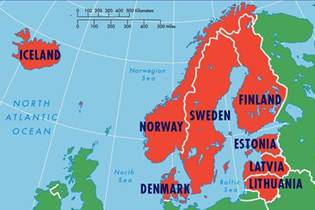
By Dr. Stasys Backaitis
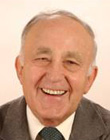 Conference on U.S.-Nordic-Baltic Cooperation:
Conference on U.S.-Nordic-Baltic Cooperation:Shaping the U.S.-European Agenda
The conference provided an overview by U.S. and European researchers and political experts on the importance, need and benefits of a close U.S. collaboration with the Nordic-Baltic region. The collaboration would facilitate building a wider and more secure Europe, reinforcing U.S. attention to transatlantic engagement, and achieving a more constructive dialog with Russia leading to democratization of its society. The conference took place on Friday, May 4, 2012, at The Paul H. Nitze School of Advanced International Studies of the John Hopkins University, Washington, D.C.
- Bookmark :
- Digg
- del.icio.us
- Stumbleupon
- Redit it
U.S.-Nordic-Baltic cooperation
- Posted by - (28) Comment


By Dr. Stasys Backaitis
 Conference on U.S.-Nordic-Baltic Cooperation:
Conference on U.S.-Nordic-Baltic Cooperation:Shaping the U.S.-European Agenda
The conference provided an overview by U.S. and European researchers and political experts on the importance, need and benefits of a close U.S. collaboration with the Nordic-Baltic region. The collaboration would facilitate building a wider and more secure Europe, reinforcing U.S. attention to transatlantic engagement, and achieving a more constructive dialog with Russia leading to democratization of its society. The conference took place on Friday, May 4, 2012, at The Paul H. Nitze School of Advanced International Studies of the John Hopkins University, Washington, D.C.
The agenda included:
|
Opening remarks. Kurt Volker, Senior Fellow, Center for Transatlantic Relations |
|
|
|
|
|
Panel Discussion |
|
|
|
|
|
Panel Discussion |
|
|
Panel Discussion |
|
|
Concluding Remarks Reception at the Lithuanian Embassy and Remarks by James Townsend, Deputy Assistant Secretary of Defense for European and NATO Policy |
This summary does not intend to deal with every specific issue addressed in this conference. Since many of the issues covered by the speakers and discussers overlapped, it would be of little value to repeat them in this summary on an author to author basis. Rather, the summary is intended to highlight the issues raised and provide the readers the general direction of the topics presented. Details of the issues addressed may be found in the Center for Transatlantic Relations publication entitled “Nordic-Baltic-American Cooperation: Shaping the U.S.-European Agenda”, John Hopkins University, Paul H. Nitze School of Advanced International Studies, May 4, 2012, Kurt Volker and Ieva Kupce, Editors.
Need for more attention towards the relationship between the United States (U.S.) and the democracies of the Nordic- Baltic Region (NB8)
The conference highlighted the need for more attention towards the relationship between the United States (U.S.) and the democracies of the Nordic- Baltic Region. Encompassing Denmark, Estonia, Finland, Iceland, Latvia, Lithuania, Norway and Sweden, the Nordic-Baltic countries (NB8) are remarkable for their economic health, their promotion of democracy, respect for human rights and the rule of law, their contribution to international security and peacekeeping operations beyond their borders, in spite of the on-going economic crisis in the EU. The values and the vision of the NB8 countries to strive and promote these policies make them valuable allies to the United States. In spite of a changing globalized world and shifting power centers, a strong transatlantic link remains indispensable for enhancing common principles and values within the Euro-Atlantic area in general, and particularly valuable and example setting between the U.S. and the NB8.
While there is some disappointment in the U.S. over Europe’s difficulties to cope effectively with the economic crisis and being an effective security partner, the NB8 nations stand out uniquely as a stable, responsible and dynamic region of Europe. The region also shows that democracy still works, that a positive onward vision of the free world is possible, and that there are still important challenges ahead for the transatlantic institutions. The conference explored how the NB8 region and the U.S. can be engaged in and cooperate to shape the broader transatlantic agenda in a positive direction.
The topics in the conference explored the vision the Nordic Baltic countries together with the U.S. might bring to the table and cooperate to shape the broader transatlantic agenda for common good and security. The conference organizers noted that concrete contributions as a result of such cooperation, in line with the EU and the NATO agendas, can be made in a number of areas such as:
- Continue to promote a Europe whole, free and at peace,
- Help aspiring European nations to join the NATO and EU
- Regional integration to attain higher levels of security than could be possible as a disparate collection of individual states and policies
- The relationship with Russia
- Energy and Cyber security
- U.S engagement with Europe
NB8 region has found ways to produce unprecedented security and stability
At a time when a larger part of the Euro-Atlantic community struggles to determine how it should address and resolve its financial and political difficulties, the NB8 region has found ways to produce unprecedented security and stability. Unlike their older EU counterparts, the Nordic and the Baltic countries have shown willingness to reform, to cooperate and to integrate where necessary. Their example of addressing together the arising challenges is a good example to the rest of the EU members on how to solve their current difficulties, leading to a Europe that is whole, free and at peace. .
The Baltic states, Norway and Finland, bordering Russia, have a direct interest and valuable perspective on living with Russia as a neighbor and managing with it security, energy and environmental issues. This provides them a better in-depth understanding and ability to interpret linkages between Russia’s authoritarian system and its external behavior. The NB8 states cannot change Russia on their own, but they can contribute to better formulated and more coherent EU, NATO and U.S. policies toward Russia.
The Baltic states, being particularly energy resources poor, stand out as models for handling complicated and intertwined energy issues with Russia while also reducing their dependency on Russia’s supplies. There is a concerted effort by all NB8 states to move towards integrated energy security by interconnecting their energy generating systems, cooperation in the development of alternative resources, and the construction of a common regional energy market. The region’s move towards greater energy security and sustainability is a good policy model to both the EU and NATO.
In view of the new U.S. Defense Policy Guidance of January 2012, in which the U.S. intends to reduce its military presence in Europe, Washington promised as compensation rotation of U.S. based brigade size forces to Europe to participate in multinational and NATO led training and military exercises. These rotations should be structured to maximize U.S-Nordic-Baltic military engagements including the use of training facilities on both sides of the Atlantic. By the use of trips across the Atlantic, the Nordic-Baltics would leverage state of the art training facilities in the United States and Canada and would enhance their readiness to undertake expeditionary operations throughout the entire NATO nordic region. Active and increasing participation by NB8 in various NATO training operations both at combat and command as well as planning levels, offer to the U.S a value model on the need to sustain a strong transatlantic engagement.
While there can be no security guarantee to the NB8 region without the U.S., there is also no sustainability of a U.S. role in the NorthAtlantic-Baltic and Central European regions without participation and contribution by the Nordic-Baltic countries. The United States needs Europe and thereby NATO, as much as Europe needs the United States as well as NATO. Transatlantic solidarity is essential to support and promote global trade, economic development, security and stability in an increasingly unpredictable world. The interdependence is best reflected in common political objectives, such as to assure a level playing field through unique transatlantic solidarity embodied by NATO. The Alliance’s new focus on partnerships at the Chicago NATO summit is in recognition of global security interdependence.
NATO and EU seem to share similar objectives in energy diversification of supplies, working toward creation of identical infrastructures and interconnectivity, response to emergencies, assistance to third countries , etc. Shale gas has been and will be a game changer in the foreseeable future. It is breaking Russia’s stranglehold on supplies to Europe. Furthermore, the developing interconnectivity of gas and electricity resources and competition in the energy market within the Nordic–Baltic region is diminishing GAZPROM’s power of monopoly. Focusing on diversification of supplies, attaining diminished vulnerability, and building a permanent framework for reduction of short and long term energy security risks are activities bringing greatest added value to energy security. This will be beneficial for both the EU and NATO, because it will make them much stronger in dealing with possible future energy crisis, and projecting stability and sustainability in their respective areas of operation. Effective NB8 cooperation supported by U.S. in the establishment of NATO Energy Security Center of Excellence in Lithuania represents a window of opportunity for attaining these goals.
NB8 countries are leaders in promoting democracy, rule of law, human rights and market based development
The Nordic-Baltic region offers many assets to the transatlantic community. They are leaders in promoting democracy, rule of law, human rights and market based development in Europe and around the world. They are also regarded as honest brokers in many hotspots of the globe. U.S.-Nordic-Baltic cooperation can serve as an important new and stable pillar to the transatlantic community. The shared vision, values, capabilities and collaboration that define the Nordic-Baltics, can be used to reanimate the effort to build a wider and more secure Europe, transatlantic stability, and help to achieve constructive dialog and cooperation with Russia. Such collaboration can also reinforce U.S. commitments to Europe’s regional security requirements and simultaneously drive forward the transatlantic community’s effort to address developing global challenges
During subsequent discussions several comments were made on the futility of the U.S. and EU to accommodate Russia’s adversarial political positions, and continuing human rights and rule of law violations. It was suggested that the West should take a strong and critical stand on these abuses with the Russian government while encouraging and facilitating developments of respect for human rights, rule of law and governance by the people through democratic institutions. While some comments indicated that the U.S. and EU currently are not in a good position to challenge Russia because of critical access to Afghanistan, others noted that Russia needs NATO presence in Afghanistan as means to reduce its vulnerability to Muslim extremism. In this regard the United States and the Nordic-Baltics should leverage their capacities and experience in a way to deepen their engagement with the Russian people and the state. Shared concerns in the Baltic Sea region such as environment protection, maritime safety, land and air transportation, could serve as platforms of common interest. Properly constructed, U.S.and NB8 cooperation could become a positive reinforcement of the insecurities encountered in the EU-U.S. transatlantic partnership. U.S.-Nordic–Baltic cooperation will also be a positive inducement to the U.S. to reinforce its commitment to maintain strong transatlantic ties as means of maintaining stability in the adjoining part of the world with minimal expense and effort.
Stan Backaitis
05/25/12
United Nordic-Baltic region will ensure economic stability and energy security
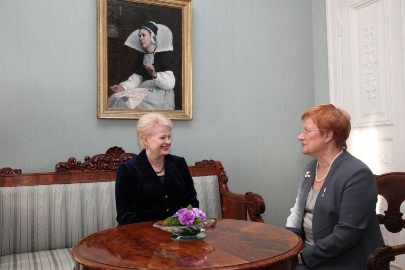
Saturday, October 29, Helsinki - President Dalia Grybauskaitė, currently on a working visit in Helsinki, met with the President of Finland, Tarja Halonen, to discuss Nordic-Baltic cooperation issues, Press Service of the President reports.
This year Finland coordinates the Nordic-Baltic Eight (NB8) cooperation with Lithuania taking over these duties next year. Lithuania and the other Baltic and Nordic countries cooperate actively in advocating the interests of the region in the EU, NATO, OSCE, and other international organizations.
“Joint efforts to strengthen the security of the region’s borders, ensure its economic stability and energy security will help create general well-being and advance progress in the Baltic-Nordic area,” the President said.
The President noted that the deepening of security cooperation was among next year’s top priorities, including border control of the Nordic and Baltic countries, closer interaction on the Baltic Sea environmental issues as well as in cyber and energy security, using to the full extent the possibilities offered by the Vilnius-based Energy Security Center.
The President underlined that the Nordic-Baltic region – one of the most rapidly developing regions in the European Union – was a dynamic driving force to advance economic stability, growth, responsible fiscal policies, innovations, and progress.
The Nordic Baltic region aspires to be among the first to put a single information space and digital market in place for accelerating electronic settlements, information exchange and access to information.
The presidents of Lithuania and Finland emphasized that keeping the Baltic Sea clean and secure for the future generations was a key commitment for all the Baltic Sea rim countries. Specific measures binding for all the nations around the Baltic Sea were set forth at the Baltic Sea Action summit held in Helsinki last year.
Tagged as: Dalia Grybauskaitė, Nordic-Baltic cooperation, Tarja Halonen
JAV-Šiaurės-Baltijos valstybių bendradarbiavimas formuojant JAV-Europos kooperavimo darbotvarkę
Dr. Stasys Backaitis, P.E., SAE Fellow
- Bookmark :
- Digg
- del.icio.us
- Stumbleupon
- Redit it
Wizz Air becomes the biggest airline in Vilnius
- Posted by - (0) Comment
![]()
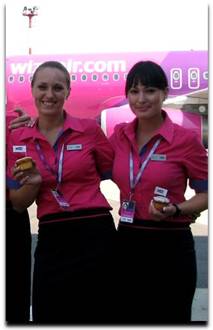
Wizz Air, the largest low-fare, low-cost airline in Central and Eastern Europe, celebrated yesterday the arrival of its second Vilnius-based aircraft, Vilnius Airport said in a statement.
Wizz Air has now increased its investment to USD 160 million at the Lithuanian capital and will carry over 500,000 passengers in the current year, outgrowing any other airline in Vilnius, writes LETA/ELTA.
This growth comes as Wizz Air commences five new Vilnius routes and offers the biggest route choice compared to any other airline at Vilnius airport. Wizz Air's 13 low-fare routes, which include the 5 new routes to Bergen, Liverpool, Oslo, Paris and Stavanger, will grow incoming tourism and allow Lithuanian families to beat the recession with low fares to the sun and exciting European cities.
- Bookmark :
- Digg
- del.icio.us
- Stumbleupon
- Redit it
- Posted by - (0) Comment
Good morning,
Mr. President!

There is no head of state in the world, other than former President Adamkus, who has been running 100 meters in 10.8 seconds... This reveals the newly released 400 page sports biography that has been prepared by sports journalist Maryte Marcinkevičiūtė. It is early morning in May 2012. I am here to interview His Excellency, President Valdas Adamkus.
Photo: Aage Myhre.
President Valdas Adamkus interviewed by Aage Myhre
aage.myhre@VilNews.com
Former President Valdas Adamkus welcomes me in his office in the rear wing of the Presidential Palace in Vilnius Old Town this early May morning. We are approaching the end of our series on the relationship between the Lithuanian-American community and the home country, and I have come here to the ex president's office to learn more about how he, as the world's most famous Lithuanian-American, looks at this relationship. I would also like to hear more about his own history in Lithuania before and during World War II, about his years in Chicago and about his time as a politician and President of Lithuania for most of the years of 1998-2009.
I must admit that I sometimes felt Adamkus was too weak in his job as president. I often wished that he more pronouncedly had called the country's nomenclature to account for their transgressions against the nation's population, and I felt much more should have be done to fight corruption, injustice, intolerance, neglect of society's weaker groups, violence, crime and other misdeeds that Lithuania is still so tragically suffering under.
But after sitting with him for nearly two hours this morning, it slowly dawned on me how impossible it must have been to change attitudes and deeds in a country that to such a high degree had been brainwashed and subjected to almost unbelievable abuses over the years under Soviet tyranny. My respect and understanding of President Adamkus grew significantly during this interview.
- Bookmark :
- Digg
- del.icio.us
- Stumbleupon
- Redit it
- Posted by - (0) Comment
Good morning, Mr. President!

There is no head of state in the world, other than former President Adamkus, who has been running 100 meters in 10.8 seconds... This reveals the newly released 400 page sports biography that has been prepared by sports journalist Maryte Marcinkevičiūtė. It is early morning in May 2012. I am here to interview His Excellency, President Valdas Adamkus.
Photo: Aage Myhre.
President Valdas Adamkus interviewed by Aage Myhre
aage.myhre@VilNews.com
Former President Valdas Adamkus welcomes me in his office in the rear wing of the Presidential Palace in Vilnius Old Town this early May morning. We are approaching the end of our series on the relationship between the Lithuanian-American community and the home country, and I have come here to the ex-president's office to learn more about how he, as the world's most famous Lithuanian-American, looks at this relationship. I would also like to hear more about his own history in Lithuania before and during World War II, about his years in Chicago and about his time as a politician and President of Lithuania for most of the years of 1998-2009.
I must admit that I sometimes felt Adamkus was too weak in his job as president. I often wished that he more pronouncedly had called the country's nomenclature to account for their transgressions against the nation's population, and I felt much more should have be done to fight corruption, injustice, intolerance, neglect of society's weaker groups, violence, crime and other misdeeds that Lithuania is still so tragically suffering under.
But after sitting with him for nearly two hours this morning, it slowly dawned on me how impossible it must have been to change attitudes and deeds in a country that to such a high degree had been brainwashed and subjected to almost unbelievable abuses over the years under Soviet tyranny. My respect and understanding of President Adamkus grew significantly during this interview.
Bring Smetona’s remains home to Lithuania!
I start my presidential interview talking about the relationship between the enormous group of Lithuanian-Americans, more than a million people, and their home country here on the Baltic Sea.
President Adamkus was born in this country in 1926 but fled to the West towards the end of World War II and came to America in 1949. During the war he contributed actively to the fight against the Nazi occupiers, and in the United States he committed himself correspondingly as strong in the fight against the Soviet occupiers, until the liberation of Lithuania
finally came in 1990-91, when he could return to continue his efforts for a strong, democratic home country on its own soil.
|
Two of the interwar presidents also fled to the United States during the WWII, Kazys Grinius (1866-1950) and Antanas Smetona (1873-1944). Adamkus was himself spending much time with Grinius in the months before he departed this life in Chicago in 1950, and was probably the one who took the very last photo of the president who led Lithuania over a relatively short period in 1926 until he was deposed by a coup d'état in December that year, on his own birthday. After Grinius' death Adamkus took an active role in giving him a dignified burial in the United States, and was also active when the ex-president's remains were sent to his homeland after the liberation of Lithuania in 1990-91. Grinius now lies buried in an honourable grave in his hometown Selema, near Marijampolė. |
|
|
The pre-war's strong man, President Antanas Smetona, who became president by a military coup in 1926 and stayed in power until the first Soviet occupation of Lithuania, in 1940 also fled to USA. In June of 1940, Smetona had proposed armed resistance against the Soviets, but the majority of the government and the commanders of the army did not concur with this proposal, and Smetona turned over the duties of President to Prime Minister Antanas Merkys, and on 15 June he and his family fled to Germany, and then on to Switzerland without surrendering his powers. In 1941, Smetona emigrated to the United States, and lived in Pittsburgh and Chicago before settling in Cleveland, Ohio in May 1942 with his son Julius' family. Smetona died in a fire at his son's house in Cleveland, on January 9, 1944, and was buried there. In 1975, his remains were moved from Cleveland's Knollwood Cemetery mausoleum to All Souls Cemetery in Chardon, Ohio. We recently brought an article here in VilNews under the title 'No flowers for Smetona', written by our correspondent Frank Passic in Michigan, in which the author claims that the former president's grave is now largely forgotten and enjoys little attention. This gave rise to an intense debate among our Lithuanian-Americans readers, where Passic's allegation was strongly opposed by those who believed that the tomb has not been forgotten.
|
|
It was also raised questions about why Smetona's remains had not been sent home to Lithuania for a similar honourable funeral and burial as was the case for Grinius. The answer given was that Smetona's family did not want this.
“Lithuania still has a long way to go until it achieves the same level of independence and self-determination it had under Smetona. That’s why to repatriate the remains of President Smetona and Sofija Smetoniene will not happen soon if at all,” writes Andris Jonas Dunduras in a comment.
I asked President Adamkus if he had an opinion about this, and he replied simply: "Send the remains back to his home country: It is sad to see that Smetona's family seems to have ended up in an internal conflict instead of thinking about what an important man he was for Lithuania. There is absolutely no reason to doubt Lithuania's safe anchorage in freedom and democracy nowadays and therefore this is not a reason not to provide a dignified burial for Smetona in his beloved homeland."
Adamkus adds that there also are many who believe Smetona was an autocratic president who does not deserve to be honoured by his home country, something he strongly disagrees with. "We must remember that such was the political situation in much of Europe throughout the interwar period. Also our neighbouring countries were led by autocrats, and it is my clear opinion, in such a perspective, that Smetona was a very good president who deserves all possible recognition for his tremendous efforts as a statesman of the highest rank," he says.
|
Then comes a sudden sadness over the President's face. And now it's he who asks me; "You know, in spite of this with Smetona, who of our three presidents from the interwar period I think has got least honour and fame for his efforts and for his incredible sufferings after being deported to a gulag in Siberia?" I nod my head, because I know well the story of Akesandras Stulginskis (1885-1969) who was Lithuania's President in the years 1920-1926, and was taken prisoner by Stalin's henchmen in 1941 at his home in Lithuania and had to suffer through 17 incredibly difficult years in Siberia, first 12 years on the gulag tundra far north, later in a self-built log cabin in Siberia's deep forests. "And not only that," explains Adamkus, "when he finally did come home in 1958 there was a disillusioned and largely destroyed, communist-ruled Lithuania that met him. Until his death 11 years later, in 1969, he was constantly exposed to humiliation and even today there is little attention to this great man of honour. It is even difficult to find his modest, anonymous grave in the Kaunas cemetery where he is buried. When I look back at my time as President, this is something I regret, that I did not do more to honour President Stulginskis with a more dignified tomb."
|
|
Almost caught by Gestapo
President Adamkus gives me more and more new details as the conversation continues. He shares with me episodes from his childhood and youth in Kaunas in the 1930s, and he talks about shocking events from the war years.
In 1944, he was just about arrested by the Gestapo for his anti-Nazi underground work.
"I thank my friend Gabrielius Žemkalnis, brother of Vytautas Landsbergis, that I’m still alive. In the years of World War II, he and I joined the resistance movement for Lithuania's independence, together with Leo Grinius, by publishing and circulating the underground, anti-Nazi newspaper “Jaunime, budek!” (Youth, Be on Guard!) in Kaunas. One day, in 1944, I was suddenly visited by Žemkalnis' sister. She said her brother had been arrested by the Gestapo, but that he had managed to whisper my name to her as he was led out of the apartment. She immediately understood that it was something he and I had together that I had to be warned about. I was still only 17 years old, but realized that this could be extremely serious, so I ran to the woods and hid there for a long time. Žemkalnis himself was first imprisoned in
Kaunas, but was later transferred to German prisons where he sat until the war was over. He never betrayed us in spite of harsh interrogation methods, and his whisper to his sister probably saved my life."

President Adamkus meeting the man who probably saved his life in 1944, Gabrielius Žemkalnis. Regina Narusiene watching.
|
Sport was always important to me In July 1944 Adamkus fled to Germany with his parents. Here he graduated from the Lithuanian Gymnasium and studied at the Faculty of Natural Science at Munich University. In 1949, he came to the United States, where he was employed as a worker in a Chicago factory of car parts, later as a draughtsman in an engineering firm. In 1951, Valdas Adamkus married Alma Nutautaitė. In 1960, he graduated from the Illinois Institute of Technology, with a degree in civil engineering. Both in Germany and in the United States young Adamkus was engaged in various activities. But strangely enough it was not politics that received his attention at first, but sports. He was an active participant and organizer of sports events and won, as an athlete, two gold and two silver medals in track-and-field events at the Olympic Games of the Enslaved Nations of 1948. In 1951, Valdas Adamkus established an academic sports club of Lithuanian Americans, Lituanica. He was chairman of the Organizing Committee of the World Lithuanian Games that were held in 1983. The President gets up from his chair opposite me, this early May morning. He goes out to the anteroom and retrieves a thick book, just published here in Lithuania. The book is about his many accomplishments in sports and organization of sports activities throughout life. He signs the book, gives it to me as a gift, and says: "It was through sport that my political career started, and, as you will see, sport has meant infinitely much to me throughout a long life." |
|
There is no head of state in the world, other than Adamkus, who has been running 100 meters in 10.8 seconds... Says the 400 page sports biography that has been prepared by sports journalist Maryte Marcinkevičiūtė.
Meeting Nixon in the White House, September 1955
While a student, Adamkus, together with other Lithuanian Americans, collected about 40,000 signatures petitioning the United States Government to intervene in the ongoing deportations of Lithuanians to Siberia by the Soviets. The petition was presented to then-Vice President Richard Nixon late September 1955.
The petition was supposed to be delivered directly to President Dwight D. Eisenhower but during a visit to his in-laws in Denver the day before, President Eisenhower suffered a serious, though not ultimately debilitating, heart attack. As it turned out, he would survive the episode by more than 13 years, more than long enough to finish a second term in 1961.
Adamkus also raised concerns about other Soviet activities in occupied Lithuania to United Nations Secretary General Dag Hammarskjöld in 1958 and to President John F. Kennedy in 1962.
“"The reactions from Moscow were uncomfortably strong. No feeling of guilt or regret of the horrible atrocities they were committing against my little country and my people."
President Adamkus' face gets a look of deep sadness as he talks about how his beloved people was torn apart and subjected to atrocities one can hardly imagine today.

In September 1955 Valdas Adamkus (28) presented a petition to then-Vice President Richard Nixon, with
40,000 signatures of young Lithuanian-Americans petitioning the United States Government
to intervene in the ongoing deportations of Lithuanians to Siberia by the Soviets
(Adamkus and VP Nixon in centre)
|
1960-1990 in USA and Lithuania Valdas Adamkus was very active in public and political life of the Lithuanian expatriate community in the U.S. between 1958 and 1965, he was vice-chairman of the Santara-Šviesa (Accord-Light) Cultural-Political Federation, a liberal civic organization of the Lithuanian expatriate community, acting under the slogan "Face to Lithuania ", and, in 1967, he was elected its chairman. While living in the United States, he was an active organizer of protests against Lithuania's occupation. Between 1961 and 1964, he was a member of the Board of the American-Lithuanian Community (LC), vice-chairman of the Centre Board, member of the American-Lithuanian Council (ALC). Starting from 1972, Valdas Adamkus visited Lithuania several times, encouraging and supporting construction of water treatment facilities and development of environmental monitoring. He assisted environmental institutions of the Baltic States with academic literature, equipment and software supply. In the capacity of the coordinator of US aid to the Baltic States in the field of environmental protection, he organized study visits for representatives of Lithuania's academic institutions and helped Vilnius University to get hold of the latest academic literature.
|
|
Early 1990s – presidential campaign with Stasys Lozoraitis
|
|
"One of my best friends through all these years, was Stasys Lozoraitis. When it became weekend he often flew in from Washington to my home in Chicago. We had many long, good conversations, particularly about the situation in Lithuania,” tells Adamkus. Stasys Lozoraitis (1924 in Berlin – 1994 in Washington, D.C.) was a Lithuanian diplomat. He was a son of Stasys Lozoraitis (1898–1983) and brother of Kazys Lozoraitis. In September 1991, following the August Putsch in Moscow and international recognition of independent Lithuania, Lozoraitis resigned the diplomatic service in favour of the national government established in Vilnius. In December 1991, he was appointed as the new government's chief diplomat to the United States, where he re-established the embassy. He was a candidate in the Lithuanian presidential election of February 1993, gathering 38.9% of vote, losing to the former communist leader Algirdas Brazauskas. |
In May 1993, just a few months after the election, Brazauskas recalled Lozoraitis as ambassador to the U.S. despite criticism of politicizing the issue. In late 1993, Lozoraitis was appointed as the ambassador to Italy.
Lozoraitis died of kidney failure at Georgetown University Hospital. He was buried in Putnam Cemetery in Connecticut and was reburied in Petrašiūnai Cemetery in Kaunas in 1999. The same year he was posthumously awarded the Order of the Cross of Vytis.
"I became campaign manager for my friend's presidential campaign on very short notice in 1993," chuckles President Adamkus. "He called me home one day while I still lived in the U.S. and said he needed my help. He had decided to pose as a candidate for the Lithuanian presidential election in February of that year, and had concluded that his Lithuanian team was not capable of running a campaign, thus, he needed my help as soon as possible. I decided quickly to request unpaid leave of absence from my job and travelled across the Atlantic to assist my friend. We realized that the chance to win at such short notice, was minimal, but we took a red marker and divided Lithuania into two, on the map.
Then we started to tour, he in one part, I in the other, to promote him as a presidential candidate, but even more to promote and explain what freedom and democracy could mean for the 'reborn' Lithuania. We won of course not, but I feel that we planted some important seeds that time almost 20 years ago."
Adamkus leans back in his chair, overwhelmed by memories, but shakes his head when I ask him if there might be something in the rumours that Lozoraities was poisoned and murdered in 1994...
President of Lithuania 1998-2003 and 2004-2009
|
|
"I've never really felt that I had the heartfelt support of Vytautas Landsbergis. He was usually lukewarm to my ideas and I saw him not as a genuine supporter neither when Lozoraitis and I worked together as hardest in 1993 or when I four years later started my campaign to become Lithuania's next president." His Excellency seems to struggle a bit to find the right words when I ask him about his relationship with Landsbergis. Searching for the right words to be honest without insulting, define without getting emotional. Nevertheless, in 1998, Valdas Adamkus was elected President of the Republic of Lithuania. He assumed the office on 26 February 1998. As President he very much promoted the idea of rapid modernization of Lithuania and worked consistently towards its implementation. |
In 2002, he ran in the presidential elections for another term, in the second round however he lost to Rolandas Paksas. In 2004, following the removal of Rolandas Paksas from the Office of the President by the Seimas of the Republic of Lithuania, Valdas Adamkus again ran in the presidential elections.
On 27 June 2004, citizens of Lithuania re-elected Valdas Adamkus President of the Republic for another five-year term. During his second term, as President of the Republic, he committed himself to create European wellbeing in every Lithuanian home and guarantee that there should not be a single abandoned person in Lithuania.
Under his presidency, Lithuania actively promoted democracy in the former Soviet, Eastern European and Asian nations. President Adamkus, together with President Aleksander Kwaśniewski, Javier Solana, Boris Gryzlov and Ján Kubiš, served as a mediator during Ukraine's political crisis, when two candidates in the 2004 presidential election, Viktor Yanukovych and Viktor Yushchenko, each claimed victory. President Adamkus recalled in an interview that "when I asked what we could do to help, Kuchma said the friends of the Ukrainian people should drop whatever they were doing and come to Kiev immediately." The next day international mediators met in Ukraine. The crisis was resolved after a new election was held.
|
|
In 2005, Adamkus, refused to participate in the 9th May ‘Victory Day’ celebrations in Moscow. He expressed the view that the war's end, in Lithuania, marked the beginning of a fifty-year Soviet occupation and repression. In response, on 22 July 2005, the United States Congress unanimously passed a resolution that Russia should "issue a clear and unambiguous statement of admission and condemnation of the illegal occupation and annexation by the Soviet Union from 1940 to 1991 of the Baltic countries of Estonia, Latvia, and Lithuania", but Russia refused. U.S. President George W. Bush went to participate in the Moscow event, but came first to Riga to meet President Adamkus and the two other Baltic presidents. “While the end of World War II brought peace, it also brought "occupation and communist oppression," Mr Bush said, apologizing to for the United States’ role in the Yalta Conference in early 1945, where the Baltic states more or less were given as hostages in a superpower play led by despot Josef Stalin.
|
"After I refused to take part in the Moscow parade, I became, in the language of diplomats, "persona non grata" for Putin. I was being ignored; he tried not to see me wherever we both came to participate in any international event,” tells the former leader of Lithuania with a wry smile, as he sits here in front of me this May morning.
President Adamkus supported an active dialogue between European Union member states and those former Soviet republics such as Georgia, Ukraine, and Moldova, that were actively seeking membership in the EU. He expressed support for these candidate members during the Community of Democratic Choice in 2005, at the Vilnius Conference 2006, and on several other occasions.

Adamkus chose not to run for re-election during the Lithuanian presidential election in 2009
and was succeeded on 12 July 2009 by Dalia Grybauskaitė.
Comments about other politicians
We have had a long, good conversation, President Adamkus and me. New visitors have already been long waiting in his anteroom. But before I go I need to know a bit more about how he looks at other leading politicians in today's Lithuania.
|
"I've obviously heard all the stories about him being corrupt and that he represented the nomenclature which ruled Lithuania in the course of the occupation years. But I always had a normal partnership with him, none of the mentioned corruption cases reached some time my president’s office. He was a good farmer, a good building, a pragmatist who people liked. And even though we were far from each other politically, we always had a relationship that was characterized by mutual respect."
|
|
|
"It is true that I was the godfather of his child, but it meant not that we had or have a very close relationship. Still, I must say that Mr. Zuokas has some extraordinary qualities and visions. I disagree with some of his actions and decisions, but I think he is a man of the future."
|
|
|
"I sympathize strongly with PM Kubilius. He has had a" mission impossible" to fight with ever since he took office as head of a government that had to do everything possible to solve the enormous challenges we faced when the financial crisis hit our country so incredibly hard four years ago. Now there will be parliamentary elections in the autumn, and opinion polls suggest that what we are going to be facing is a coalition government without a majority for any party or group. We are still facing major problems, and I sincerely hope that people will understand this while voting and that it will be found solutions that provide continued strength and good development for our country."
|
|
|
"It would not be appropriate for me to sit here and criticize my successor. The only thing I will say is that I occasionally ask myself what has happened to Lithuania's foreign policy. I have, frankly, become more and more confused. I always emphasized that Lithuania’s way is to have closest possible relations with the West, and not wobble in this respect. What I have seen over the past three years, is that one day there seems to be one attitude, while the next day seems to follow a completely different direction. That worries me." "Has the current president asked for advice from you since she took office in July 2009?"
|
|
My time with President Adamkus has come to an end.
Biography
|
|
|
|
|
|
Valdas Adamkus was born into a family of civil servants in Kaunas on 3 November 1926. He studied at the Jonas Jablonskis Elementary School and the Aušra (Dawn) Gymnasium in Kaunas. During World War II, he was involved in the resistance movement for Lithuania 's independence. Valdas Adamkus fled to Germany with his parents in July 1944. After graduation from the Lithuanian Gymnasium in Germany , Valdas Adamkus studied at the Faculty of Natural Science at Munich University. In 1949, Valdas Adamkus came to the United States , where he was employed as a worker in a Chicago factory of car parts, later, as a draughtsman in an engineering firm. In 1960, he graduated from the Illinois Institute of Technology, with a degree in civil engineering. In 1951, Valdas Adamkus married Alma Nutautaitė. |
Professional Career
In early 70's Valdas Adamkus was invited to work for a newly established US federal environmental institution, the US Environment Protection Agency (EPA). He headed the Environment Research Centre and was later appointed deputy administrator at the US EPA Region 5 (Midwest Region). In 1981, he was promoted to administrator of the Environment Protection Agency.
Face to Lithuania
Valdas Adamkus was active in public and political life of the Lithuanian expatriate community. Between 1958 and 1965, he was vice-chairman of the Santara-Šviesa (Accord-Light) Cultural-Political Federation, a liberal civic organization of the Lithuanian expatriate community, acting under the slogan "Face to Lithuania ", and, in 1967, he was elected its chairman.
While living in the United States , Valdas Adamkus was an active organizer of protests against Lithuania 's occupation and the initiator of numerous petitions. Between 1961 and 1964, Adamkus was a member of the Board of the American-Lithuanian Community (LC), vice-chairman of the Centre Board, member of the American-Lithuanian Council (ALC).
Valdas Adamkus was an active participant and organiser of sports events. He won two gold and two silver medals in track-and-field events at the Olympic Games of the Enslaved Nations of 1948. In 1951, Valdas Adamkus established an academic sports club of Lithuanian Americans, Lituanica. He was chairman of the Organizing Committee of the World Lithuanian Games that were held in 1983.
Since 1972, Valdas Adamkus had been visiting Lithuania once or several times a year. Encouraging and supporting construction of water treatment facilities and development of environmental monitoring, Valdas Adamkus assisted environmental institutions of the Baltic States with academic literature, equipment and software supply.
In the capacity of the coordinator of US aid to the Baltic States in the field of environmental protection, Valdas Adamkus organized study visits for representatives of Lithuania 's academic institutions and helped Vilnius University to get hold of the latest academic literature.
In 1993, Valdas Adamkus headed the election campaign of presidential candidate Stasys Lozoraitis in Lithuania .
Consolidating the moderate political centre, he was actively involved in the campaign of the 1996 Lithuanian general parliamentary elections.
President of the Republic
In 1998, Valdas Adamkus was elected President of the Republic of Lithuania. He assumed the office on February 26, 1998. President Adamkus promoted the idea of rapid modernisation of Lithuania and worked consistently towards its implementation.
In 2002, Valdas Adamkus ran in the presidential elections for another term, in the second round however he lost to Rolandas Paksas. Upon completion of his term in the office, Valdas Adamkus remained active in domestic and foreign politics and gave lectures at international conferences.
In 2004, following the removal of Rolandas Paksas from the Office of the President by the Seimas of the Republic of Lithuania, Valdas Adamkus again ran in the presidential elections.
On June 27, 2004, citizens of Lithuania re-elected Valdas Adamkus President of the Republic for another five-year term. During his second term, President of the Republic is committed to create European wellbeing in every Lithuanian home and to guarantee that there is not a single abandoned person in Lithuania .
UNESCO Goodwill Ambassador for the Construction of Knowledge Societies
In 2003, President Valdas Adamkus was conferred the title of UNESCO Goodwill Ambassador for the Construction of Knowledge Societies. This title is held only by 42 individuals in the whole world, therefore, this honour shown to President Valdas Adamkus can certainly be viewed as the award to all the people of Lithuania .
In the area of knowledge society, UNESCO is involved in internet promotion, establishment of community internet centres, library and archive modernisation, development of E-government, implementation of information technologies in educational, women’s and children’s teaching institutions and decision-making structures.
With its own Goodwill Ambassador, Lithuania has now become even more visible among UNESCO member states.
Awards
In 1988, Valdas Adamkus was granted the International Environmental Award for outstanding achievements in the international arena. He has also been awarded the US Environmental Protection Agency’s Gold Medal, the US President’s Award for Outstanding Service and the International Olympic Committee Award.
Valdas Adamkus was named the European of the Year 2007 at the European Voice Awards. In 2008, he was conferred the title of Academician of the Lithuanian Olympic Academy for many years of active involvement in the Olympic movement and the promotion of its ideals.
The President of Lithuania has been bestowed 33 highest-class state decorations of various countries, including the Golden Collar of the City of Athens, the Order of Iron Wolf of the Lithuanian Scouts Union, the Order of Star of the Lithuanian Riflemen’s Union and the International Olympic Committee Award for Sport and Promotion of Olympism.
- Grand Cross of the Order of the Falcon, Iceland, 1998
- Grand Cross of the Order of St. Olav, Norway, 1998
- Order of Yaroslav the Wise, 1st Class, Ukraine, 1998
- Collar of the Order of the Cross of Terra Mariana, Estonia, 1999
- Grand Cross of the Order of the Redeemer, Greece, 1999
- Collar and Grand Cross of the Order of Merit of the Italian Republic, 1999
- Order of the White Eagle, Poland, 1999
- Grand Cross of the Order of Merit, Malta, 1999
- Grand Cross of the Order of Merit, Hungary, 1999
- Grand Cross of the Order of Friendship, Kazakhstan, 2000
- Grand Cross with Collar of the Order of the Three Stars, Latvia, 2001
- Grand Cross of the Order of the Legion of Honour, France, 2001
- Collar of the Star of Romania, Romania, 2001
- St. Mesrob Mashtots Order, Armenia, 2002
- Grand Cross of the Order of the White Rose with Collar, Finland, 2002
- Order “For Special Merits”, Uzbekistan, 2002
- Order of Vytautas the Great with the Golden Collar, Lithuania, 2003.
- Collar and Grand Cross of the Order of the White Star, Estonia, 2004
- Order of Isabella the Catholic with Collar, Kingdom of Spain, 2005
- Special Class of the Grand Cross of the Order of Merit, Germany, 2005
- Order of the White Double Cross, 1st Class, Slovakia, 2005
- Grand Cordon of the Order of Leopold, Kingdom of Belgium, 2006
- Grand Cross with Collar of the Order of Merit of the Republic of Hungary, 2006
- The Most Honorable Order of the Bath, United Kingdom, 2006
- Order for Merit, 1st Class, Ukraine, 2006
- Order “Mother Theresa”, Albania, 2007
- Grand Cordon of the Supreme Order of the Chrysanthemum, Japan, 2007
- Grand Collar of the Order of Infante D. Henrique, Portugal, 2007
- St. George’s Victory Order, Georgia, 2007
- Grand Cross of the Order of the Netherlands Lion, 2008
- Collar of the Order for Merits to Chile, Republic of Chile, 2008
- Grand Star of the Decoration of Honour for Services to the Republic of Austria, Republic of Austria, 2009
- Order of Stara Planina, Republic of Bulgaria, 2009
Honorary Doctor
Valdas Adamkus is the Honorary Doctor of universities in Lithuania and other countries:
- Vilnius University, 1989,
- Indiana St. Joseph's College, USA, 1991,
- Northwestern University, USA, 1994,
- Kaunas Technological University, 1998,
- The Catholic University of America, USA, 1998,
- University of Agriculture of Lithuania , 1999,
- Illinois Institute of Technology, USA, 1999,
- Eurasian University, Kazakhstan, 2000,
- De Paul University in Chicago, USA , 2001,
- Law University of Lithuania , 2001,
- Vytautas Magnus University, 2002,
- Lithuanian Academy of Physical Education, 2004,
- Yerevan State University, Armenia, 2006,
- Baku State University, Azerbaijan, 2006,
- Notre Dame University, USA, 2007,
- Nicolaus Copernicus University in Toruń, Poland, 2007,
- Tallinn University, Estonia, 2008,
- University of Chile, Chile, 2008.
- Bookmark :
- Digg
- del.icio.us
- Stumbleupon
- Redit it
- Posted by - (0) Comment
 |
VilNews is in Azerbaijan
|
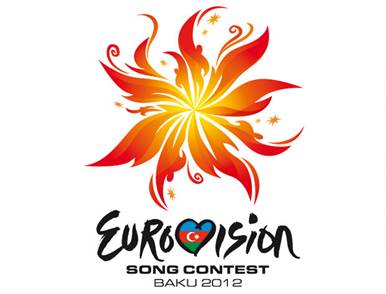
By Arvydas Arnasius
To tell frankly Azerbaijan was not on my list of countries which I wanted to go no matter what and when there was an opportunity to visit it during the 2012 Eurovision song contest in Baku I had a reserved expectations.
For the reader I can tell that Azerbaijan is neither Europe nor Asia and this country has an incredible tangle of contradictions and contrasts. It’s fascinating nexus of ancient historical empires going back centuries ago. Yet it’s also a new and dynamic nation finding its way from the emergencies from war-torn post-Soviet times on petroleum funded explosion of optimism. Surrounded by the semi-desert on the oil rich Caspian Sea, the nation’s cosmopolitan capital – Baku, is a dynamic boom-town, where flashy limousines and mushrooming skyscrapers sweep around the picturesque old town. Yet barely few hours’ drive away there is another reality - entirely different world: timeless villages with their people and soaring high Caucasus mountains.
- Bookmark :
- Digg
- del.icio.us
- Stumbleupon
- Redit it
- Posted by - (2) Comment
 |
VilNews is in Azerbaijan
|

By Arvydas Arnasius
Azerbaijan is neither Europe nor Asia and this country has an incredible tangle of contradictions and contrasts. It’s fascinating nexus of ancient historical empires going back centuries ago.
Until the 20th century the ancient term Azerbaijan applies largely to ethnical territory centered on Tabriz and Ardabil in Iran. Over the last two thousand years it’s not just a country name and rules that have changed but also its religion, language and its ethnicity. Having spent most of that time straddling its territories of competing empires, understanding this extraordinary saga really requires understanding of the Persian, Arab, Turkish and Russian histories.
Today Azerbaijan is a new and dynamic nation finding its way from the emergencies from war-torn post-Soviet times on petroleum funded explosion of optimism. Surrounded by the semi-desert on the oil rich Caspian Sea, the nation’s cosmopolitan capital – Baku, is a dynamic boom-town, where flashy limousines and mushrooming skyscrapers sweep around the picturesque old town. Yet barely few hours’ drive away there is another reality - entirely different world: timeless villages with their people and soaring high Caucasus mountains.
The Azeri capital is Caucasus largest and most cosmopolitan city. Few cities in the world are as quickly and nowhere else in Caucasus do East and West blend as seamlessly or as chaotically. Beat up Ladas race shiny Mercedes past illuminated stone mansions, shiny glass towers and tatty old Soviet apartment blocks. Fascinating Old City surrounded by the medieval fortress wal I protected by Unesco World Heritage Foundation. The name Baku is derived from the Persian bad cube (city of winds) with the gale force winds coming from the Caspian once or twice a month.

Baku is hosting 2012 Eurovision Song Contest which will be the 57th annual Eurovision Song Contest. It is held in Baku, Azerbaijan, following Azerbaijan's win in the 2011 Contest. The two semi-finals will be held on 22 May and 24 May 2012, and the final on 26 May 2012.Ten countries from each semi-final will qualify for the final and will be joined by Azerbaijan, France, Germany, Italy, Spain and the United Kingdom. Forty-two countries is participating in this event.
The country took this challenge very seriously with the big development project - the venue Baku Crystal Hall in the Azerbaijani capital. On 16 May 2011, it was announced that a special concert complex with 23,000 seats for the 2012 Contest was to be built near National Flag Square in Baku. The foundations were completed on 14 October 2011 and now the hall is completely finished. There is no official information released on the cost involved in developing the infrastructure and the venue yet but, according to experts, they can easily reach over a couple of billion euros.
2012 Eurovision song contest is considered to be a major rehearsal for the Azerbaijan's capital, Baku, plans to bid for the Olympics, with initial studies suggesting that the cost of hosting the 2016 Summer Olympic Games may be $20 billion.
Azerbaijan with its booming capital and strive to be part of Europe accompanied by its people positive attitude and deeply inherited sense of hospitality is standing a good chance winning this Olympic bid and always be enjoyable and highly memorable places to visit.
Key Facts on Azerbaijan
Area: 86,600 sq km.
Capital: Baku
Famous for: Oil, saffron, caviar
Official name: Azarbaycan Respublikasi
Population: 7,830,000




- Bookmark :
- Digg
- del.icio.us
- Stumbleupon
- Redit it
- Posted by - (0) Comment
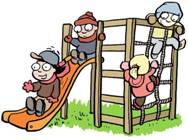
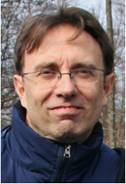
Gene Emmer
Last month, I wrote an OPEN LETTER to Mayor Zuokas pointing out the need for more playgrounds in the old town of Vilnius. In it, I recommended amongst other things, building new playgrounds in places such as the Rudininku Skveras and improving the playground located behind the post office on Vokieciu Gatve (behind the Post). To my delight and surprise, both have happened! Perhaps these were already planned before my letter, I have no idea. But nevertheless, I am very pleased that the city of Vilnius is making these improvements.
The new playground in Rudininku Skveras opened this week to a very appreciative audience of children and parents. So delighted were they, that the playground was absolutely packed with children. When we were there, about 30 youngsters were enjoying themselves, a very high number for such a small park.
On the Vokieciu playground, one can see some recent attempts at landscaping slowly appearing. Perhaps this is the beginning of much needed renovations.
We can only hope that the city continues to make such improvements. The fact that the few existing playgrounds are so busy only underscores the need for more opportunities for children of the old town to play and breath fresh air.
Gene Emmer,
Vilnius
- Bookmark :
- Digg
- del.icio.us
- Stumbleupon
- Redit it
- Posted by - (0) Comment


Gene Emmer
Last month, I wrote an OPEN LETTER to Mayor Zuokas pointing out the need for more playgrounds in the old town of Vilnius. In it, I recommended amongst other things, building new playgrounds in places such as the Rudininku Skveras and improving the playground located behind the post office on Vokieciu Gatve (behind the Post). To my delight and surprise, both have happened! Perhaps these were already planned before my letter, I have no idea. But nevertheless, I am very pleased that the city of Vilnius is making these improvements.
The new playground in Rudininku Skveras opened this week to a very appreciative audience of children and parents. So delighted were they, that the playground was absolutely packed with children. When we were there, about 30 youngsters were enjoying themselves, a very high number for such a small park.
On the Vokieciu playground, one can see some recent attempts at landscaping slowly appearing. Perhaps this is the beginning of much needed renovations.
We can only hope that the city continues to make such improvements. The fact that the few existing playgrounds are so busy only underscores the need for more opportunities for children of the old town to play and breath fresh air.
Gene Emmer,
Vilnius
- Bookmark :
- Digg
- del.icio.us
- Stumbleupon
- Redit it
- Posted by - (0) Comment
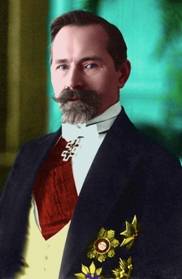
Antanas Smetona (1874 – 1944) served as the first President of Lithuania from April 4, 1919 to June 19, 1920. He again served as the last President of interwar Lithuania from December 19, 1926 to June 15, 1940, before the Soviet occupation. He was also one of the famous ideologists of nationalism in Lithuania.
- Bookmark :
- Digg
- del.icio.us
- Stumbleupon
- Redit it
President Grybauskaite says Europe’s crisis may delay Lithuanian Euro plan
- Posted by - (0) Comment
![]()
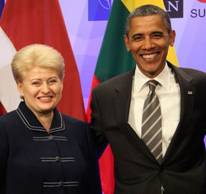
President Grybauskaite and President Obama meeting in Chicago.
The European Union, battling with its sovereign debt crisis, may not be ready to expand the euro area to the east in 2014 when the Baltic nations of Lithuania and Latvia prepare to switch currencies, Lithuanian President Dalia Grybauskaite said.
If Europe is ready, “of course we will join,” Grybauskaite said in an interview yesterday with Bloomberg News in Chicago. “It’s not only about Lithuania. It’s about Europe. Will Europe be ready to enlarge in 2014 because still we are seeing pending a lot of difficulties in the south of Europe, probably new elections in Greece.”
The Baltic nations of Latvia and Lithuania are next in line to switch currencies to the euro, while other governments across eastern Europe including the Czech Republic, Poland and Hungary are slowing preparations for the changeover as the euro region grapples with the debt crisis. Doubts are mounting on whether Greece can remain in the 17-nation currency zone as it prepares for June 17 elections following an inconclusive May 6 ballot.
Both Latvia and Lithuania peg their currencies to the euro with the official government goal of joining Europe’s monetary union in 2014.
- Bookmark :
- Digg
- del.icio.us
- Stumbleupon
- Redit it
VilNews e-magazine is published in Vilnius, Lithuania. Editor-in-Chief: Mr. Aage Myhre. Inquires to the editors: editor@VilNews.com.
Code of Ethics: See Section 2 – about VilNews. VilNews is not responsible for content on external links/web pages.
HOW TO ADVERTISE IN VILNEWS.
All content is copyrighted © 2011. UAB ‘VilNews’.

 Click on the buttons to open and read each of VilNews' 18 sub-sections
Click on the buttons to open and read each of VilNews' 18 sub-sections 








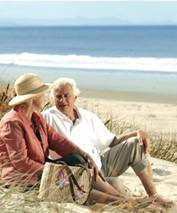

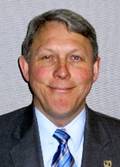
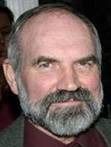






















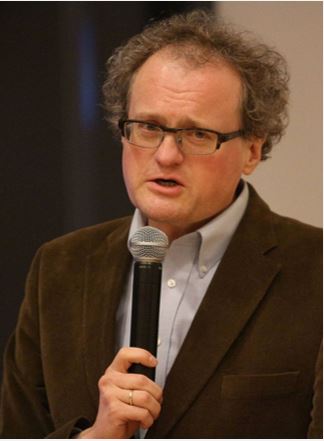
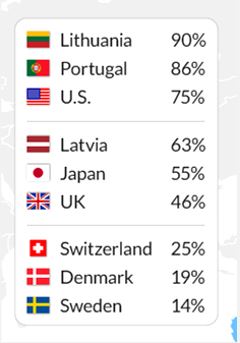
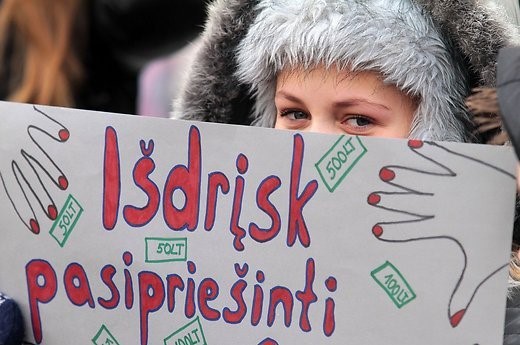


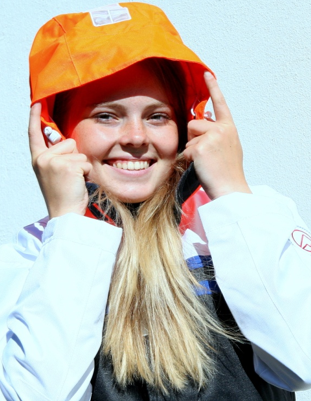
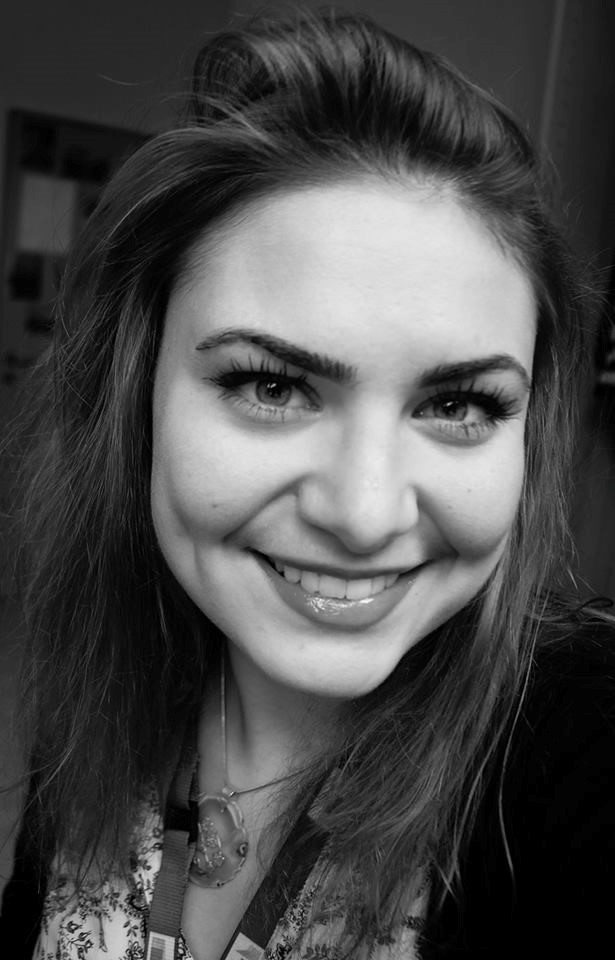
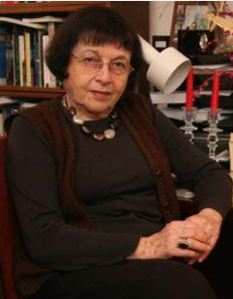
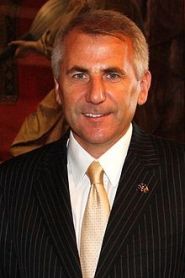
.jpg)
